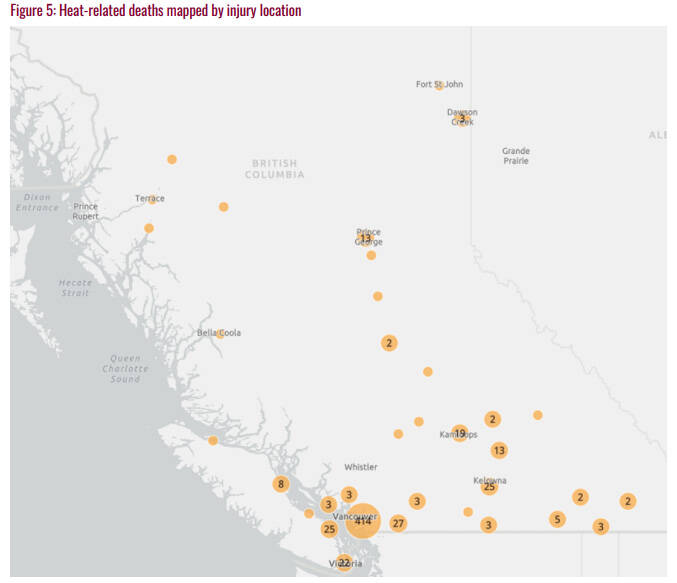The BC Coroners Service has released its review of the deadly 2021 heat dome, along with recommendations calling for both immediate and long-term solutions and a greater focus on vulnerable populations.
Its final tally of the number of heat-related deaths between June 25 and July 1, 2021 is 619 B��Ԫ������ַ� slightly more than its original estimation. Of those, the majority were among older people, those living alone, and those with health conditions.
Most people lived without cooling systems
The BC Coroner Service found 67 per cent of people who died were 70 or older, 90 per cent were 60 or older and none were younger than 30. More than half lived alone and the vast majority of people who died were found without air conditioning (93 per cent) or fans (76 per cent).
The vast majority (91 per cent) had at least one chronic disease, such as hypertension (71 per cent), mood and anxiety disorders (60 per cent), depression (54 per cent), diabetes (37 per cent) and osteoarthritis (33 per cent). The review says many of these could have impacted a personB��Ԫ������ַ�s mobility and cognition during the heat dome.
Nearly three-quarters of those who died lived in the Vancouver Coastal or Fraser health authorities, the review found, and about one third lived in materially or socially deprived neighbourhoods.
All but two per cent of deaths occurred indoors, 73 per cent of which were in private residences. Another 10 per cent occurred in social or supportive housing, seven per cent in mobile homes or RVs and seven per cent in long-term care homes.
READ ALSO:
Map
911 calls doubled during heat waveB��Ԫ������ַ�s peak
The BC Coroners Service says over the one week heat wave, temperatures rose to a peak of over 40 C in many parts of the province.
During the height of the wave, the review found 911 calls doubled (11,970 calls on June 28) and emergency response times lagged. Paramedics attended 54 per cent of deaths in a median time of 10 minutes and 25 seconds. They took 30 minutes or longer to arrive on scene in 50 instances.
In another 17 instances, 911 callers were put on extended holds, and in six instances callers were told there was no ambulance available.

Heat emergencies added to alert system
The BC Coroners ServiceB��Ԫ������ַ�s recommendations are lumped into three main categories: implement a coordinated provincial heat alert and response system, identify and support populations most at risk of dying during heat emergencies, and implement heat prevention and long-term strategies.
The province fulfilled the first recommendation in an announcement Monday. It is adding heat emergencies to the list of events it will use the Alert Ready system for, which already notifies people of tsunamis, floods, wildfires, civil emergencies and Amber Alerts through radio and television broadcasts and text messages.
Under the BC Heat Alert and Response System, the provinceB��Ԫ������ַ�s new dedicated heat committee will issue either warnings or emergency alerts, depending on different temperature thresholds throughout the province. If a region is expected to see two or more consecutive days with daytime highs and nighttime lows above what is considered normal, a warning will be issued. If temperatures are expected to continue to increase day over day for three or more days, an extreme heat emergency will be declared and the Alert Ready system may be used.
The province says it expects to issue heat warnings one to three times a summer, and extreme heat emergencies once or twice a decade.
The BC Coroners Service says the Ministry of Health will conduct an evaluation of the system by summer 2023.
READ ALSO:
WATCH: Province announces details of BC Heat Alert and Response System
Making cooling devices a priority
The review also sets out a number of target dates for the province to address the disproportionate impact heat events have on vulnerable populations. By the end of June, health authorities are to ensure home and community care services have identified and prioritized clients with chronic diseases, with limited mobility, with cognitive impairments and who live alone, for home visits during extreme heat events.
By December, the province is told to conduct a review into issuing cooling devices as medical equipment to people most at risk of dying. It is also expected to consult directly with vulnerable populations by June 2023.
Recommendations for long-term strategies include MondayB��Ԫ������ַ�s release of a , making passive and active cooling measures eligible for rebates by summer 2023, as well as making them a requirement in the 2024 BC Building Code and for existing home renovations.
Speaking Tuesday, chief medical officer Dr. Jatinder Baidwan said they chose the timelines around cooling devices based on what they thought would be realistic for the province to implement. He added that while air conditioners may be the best immediate solution, the province should also consider the long-term negative impact their use has on the climate.
Climate change as the overarching issue
The review noted that there was a lag between Environment and Climate Change Canada issuing heat alerts and agencies and people in B.C. taking action.
Baidwan said part of the issue was that the alert wasnB��Ԫ������ַ�t taken as seriously as it should have been. He said the larger problem is in how we have planned our cities and living spaces, though.
B��Ԫ������ַ�ItB��Ԫ������ַ�s a failure of the way that we live,B��Ԫ������ַ� he said.
One of the reviewB��Ԫ������ַ�s final recommendations is that the Ministry of Environment and Climate Change Strategy acts to ensure future local government plans fall inline with climate preparedness plans. This could include increasing urban tree canopy, heat reflectivity and the number of permeable surface areas to absorb water.
Speaking in response Tuesday afternoon, Solicitor General and Public Safety Minister Mike Farnworth said the province would review and consider all the recommendations.
READ ALSO:
jane.skrypnek@bpdigital.ca
Like us on and follow us on .




